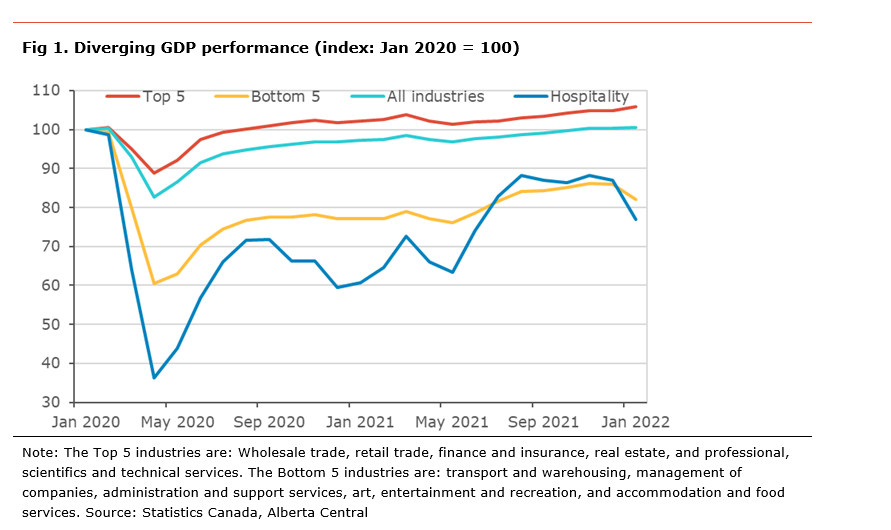Economic insight provided by Alberta Central Chief Economist Charles St-Arnaud.
Bottom line
Today’s release of the GDP for January shows that the hit to the economy from the Omicron wave was short-lived, with the advance estimate for February suggesting a solid rebound in economic activity. With COVID-related restrictions further reduced in March in many provinces, growth should remain robust.
The Canadian economy is expected to exhibit strong momentum going into the second quarter. However, with the Bank of Canada expected to remove its monetary stimulus aggressively (see), some sectors will start to feel the impact of higher interest rates and higher energy prices.
For Alberta, the GDP for February shows that a decline in some key industries, especially the oil and gas sector, likely means that economic activity during the month was weaker than in the rest of the country.
The monthly GDP rose by 0.2% m-o-m in January (+3.5% y-o-y), in line with the preliminary estimate. With this increase, the level of economic activity is currently above its pre-pandemic level by 0.4%.
The details show that only 9 out of 20 industrial sectors posted gains on the month, with hard-to-distance sectors posting big declines due to the impact of the Omicron wave. With the overall level of economic activity being above its pre-COVID level, 12 out of 20 industrial sectors have economic activity above pre-pandemic levels: agriculture, utilities, construction, wholesale trade, retail trade, information and culture, finance and insurance, real estate, professional, scientific and technical services, education, health care, and public administration.
Statistics Canada’s preliminary estimate for February suggests growth rebounded by 0.8% m-o-m. The advanced information indicates strong increases in activity in manufacturing, natural resource extraction, accommodation and food services, and construction.
The goods-producing side of the economy rose by 0.8% m-o-m in January. Construction activity rebounded (+2.8% m-o-m), due to strong residential building construction. Utilities surged (4.0% m-o-m), as below seasonal temperatures in Western Canada boosted demand for electricity and natural gas. Agriculture was up 2.5% m-o-m. On the flip side, natural resource extraction declined 1.2% m-o-m and manufacturing by 0.5% m-o-m.
The services-producing side of the economy was flat on the month. The Omicron wave lead to sharp declines in activity in arts, entertainment and recreation (-10.8% m-o-m), and in accommodation and food services (-11.5% m-o-m). Transportation and warehousing was also impacted (-3.0% m-o-m), with big decline in ar transportation and urban transit. There were also declines in information and culture (-0.8% m-o-m), management of companies (-2.7% m-o-m). Those declines were offset by gains in wholesale trade (+3.1% m-o-m) and retail sales (+2.5% m-o-m). Better availability of products in both sectors allowed the increase in activity. There were also gains in professional, scientific and technical services (+0.5% m-o-m), real estate and leasing (+0.4% m-o-m), and finance and insurance (+0.3% m-o-m)
For Alberta, there is no specific data in the report. However, we can make an assessment based on activity in some key industries specific to Alberta. The sharp rise in activity in the agricultural sector, driven primarily by the crop production sector (+11.0% m-o-m), suggests the sector supported growth on the month. However, a big decrease in the non-conventional oil sector (-2.2% m-o-m), in support activities for mining oil & gas (-1.1% m-o-m) and pipeline activity (-0.7% m-o-m) were likely that main drag. Overall, the Alberta economy was likel weaker than the rest of the country in January.



Independent Opinion
The views and opinions expressed in this publication are solely and independently those of the author and do not necessarily reflect the views and opinions of any organization or person in any way affiliated with the author including, without limitation, any current or past employers of the author. While reasonable effort was taken to ensure the information and analysis in this publication is accurate, it has been prepared solely for general informational purposes. There are no warranties or representations being provided with respect to the accuracy and completeness of the content in this publication. Nothing in this publication should be construed as providing professional advice on the matters discussed. The author does not assume any liability arising from any form of reliance on this publication.
Alberta Central member credit unions can download a copy of this report in the Members Area here.